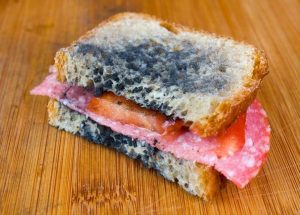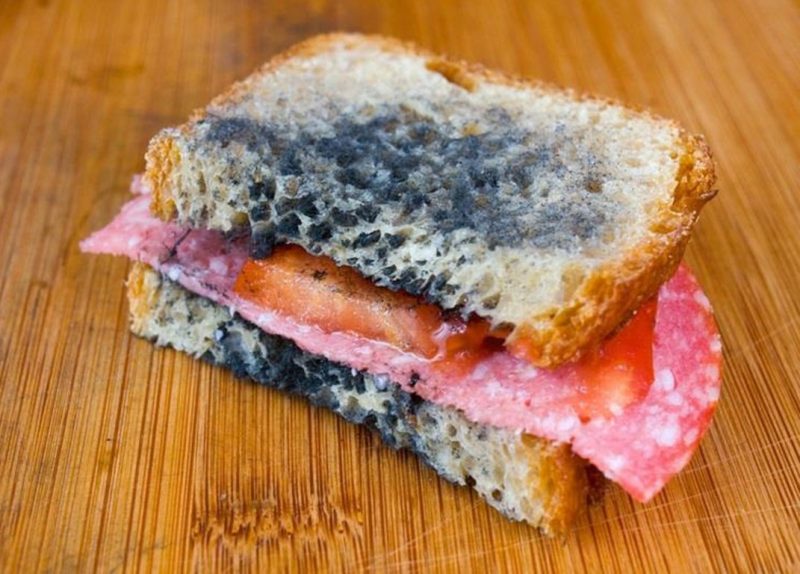 It has certainly already happened to many of us to open our food pantry and find some food covered in mold.
It has certainly already happened to many of us to open our food pantry and find some food covered in mold.
But not all of us will have reacted the same way.
Some will have thrown the food away and some will only have removed the moldy part and eaten the rest.
It’s not always easy to know when it’s safe to eat moldy food and when it’s better to simply discard it.
The topic may be a bit confusing as some foods are actually produced with mold and have been consumed safely for centuries.
For example, many types of cheese, including Gorgonzola, Brie or Camembert, are produced with a type of mold called Penicillium.
So, if the mold used to produce cheese is safe, why would moldy food be potentially dangerous? And if it is dangerous, to what extend and under which conditions?
Mold is naturally present in our environment and it’s impossible to avoid it completely.
However, it can be potentially dangerous and some precautions are necessary to avoid risks for our health.
In this article we will talk about its potential risks as well as the most effective ways to avoid the mold and the problems it can create.
What is Mold?
To avoid mold, the first step is to understand what it is.
This word refers to fungi that grow in multicellular structures.
When the fungi grow in single cells, we call them yeast instead.
Mold can have different colors, such as green, black, grey or white.
It can also float in the air, in which case it will be invisible to naked eye.
Mold grows quicker in hot and humid conditions, such as tropical climates or summer.
Moist, warm and organic substances such as food are the perfect environment for it to develop.
Common foods that can grow mold are fruit and vegetables, bread, meat, nuts, milk products and cheese, spices, some processed foods and some crops such as corn, oats and rice.
However, food is not the only matter at risk.
Mold can also develop on leather goods, clothes or shoes, as well as on our pets and even our bodies.
As already mentioned, mold spores can also float in the air.
Dangers of Molds
Not all types of mold are dangerous.
Yet, some can potentially be very harmful.
First of all, mold can be inhaled and create breathing problems, asthma, as well as allergic reactions.
Even worse, some types of mold can produce toxic substances, called mycotoxins.
According to the Food and Agriculture Organization (FAO) of the United Nations, these are present in 25% of the world’s crops, especially maize and peanuts.
Aflatoxins are probably the most well-known – and researched on -type of mycotoxins.
It’s a very dangerous substance, classified as carcinogenic.
According to the International Agency for Research on Cancer (IARC) of the World Health Organization (WHO), this substance is poisonous and its acute contamination can even lead to death.
It can cause liver cancer too, especially in people that already suffer from hepatitis B chronic infection.
More recently, it has also been observed that children that are exposed to high quantities of aflatoxins can develop the symptoms of stunting and growth impairment.
These conditions make them more vulnerable to other illnesses such as infectious diseases.
As a result, their mortality risk is also increased, especially in developing countries.
What is more, bacteria can also develop on food together with mold.
This combination can provoke food-borne diseases with symptoms like nausea, diarrhea and vomiting.
Surprisingly, studies also highlighted a link between mold and psychiatric disorders.
For example, a study led by Brown University in 2007 found “a solid association between depression and living in a damp, moldy home.”
How to Prevent Mold Growth?
Although not all types of mold are dangerous, some are potentially very harmful and exposure to them should therefore be reduced as much as possible.
Firstly, as mold develops quickly in hot and humid conditions, it’s important to control the temperature and humidity level at home.
The desirable humidity level should be below 40%. Air-conditioning and dehumidifiers can be used to achieve this goal.
Secondly, food and leftovers should be handled with care to avoid the growth of mold on them.
According to the US Department of Agriculture (USDA), the following precautions should be followed when dealing with food:
- leftovers should be eaten within 3 or 4 days of preparation so that mold does not have enough time to grow on it;
- perishable food should always be refrigerated and should not be left outside the fridge for more than 2 hours;
- the content of opened cans should be stored in a clean and well-sealed container and kept refrigerated;
- for longer-term storage, it is preferable to freeze food quickly rather than keeping it in the fridge;
- as mold spores can be airborne as well, whenever food is served, it should be covered to avoid contact with them.
It may be also a good idea to buy fresh produce in small quantities to avoid letting them rot over time.
Hygiene in the kitchen is very important as well. Sponges, mops, towels and cloths should always be kept dry, clean and fresh.
A damp smell is a clear indicator that the item should be washed or, if this is not possible, discarded.
Strict hygiene rules should also be followed inside the fridge.
In fact, even though the cold temperature of the refrigerator is not its favourite environment, mold can actually grow there as well.
For this reason, the fridge should be cleaned regularly, at least monthly or bimonthly.
According to USDA, the best cleaning product for this is 1 tbsp of baking soda mixed with 1 dl of water.
Since mold can be airborne, indoor air quality at home and in the office is very important too.
Regular ventilation should be ensured and indoor air pollution should be monitored and tested whenever possible.
Can I Salvage Moldy Food?
So, let’s go back to our initial question: what should I do if my food is moldy?
USDA answered this query very clearly in a chart listing the different types of foods and explaining which ones should be discarded and which ones should be salvaged when moldy.
This is the list of foods that unfortunately cannot be salvaged and should be discarded as soon as they are contaminated by mold:
- luncheon meats
- bacon and hot dogs
- cooked leftover meat and poultry
- cooked casseroles
- cooked grain and pasta
- soft cheese; yogurt
- jams and jellies
- soft fruit and vegetables
- bread and baked goods
- peanut butter
When it comes to hard salami and dry-cured country hams, mold on their surface is normal so they can still be eaten safely.
The only precaution is to scrub off the surface mold before consuming them.
Hard cheese, as well as firm fruit and vegetables, can be used even if they are contaminated by mold.
In fact, their solid texture prevents mold from penetrating deeper.
However, the moldy spot and the area around it should be removed before eating them.
It is recommended to remove at least 1 inch around the contaminated area.
Although not all types of mold are dangerous, some can be very harmful and even potentially toxic.
Mold is everywhere, so nobody can be completely protected against it.
Consequences will be more or less serious depending on the extent of exposure and the type of mold.
Against this background, mold should be avoided as much as possible, especially when in direct contact with food.
Therefore, we should all observe proper cleanliness and hygiene in the kitchen, especially when storing and preparing food.
Furthermore, since airborne mold spores are invisible to naked eye, we should always remember to ventilate our house regularly as this is the place where many of us spend much of the time and contamination is more likely to happen.
If you’ve accidentally eaten molds and suffered from digestive issues like boosting, gas, constipation indigestion, go to the next page and learn about the 3 tips to heal your digestive system –
About the Author:
Emma Deangela is the best selling author of The Alkaline Diet Program and 80/20 Fat Loss. She has helped over tens of thousands of men and women to lose weight and transform their health with sound nutrition advice. Learn how you can lose weight fast – How to lose weight by adding these alkaline foods.
When is the last time the food you bought turned moldy?
Please share with your friends this article on Moldy Food so they will learn what food can still be savaged or they should throw away – Use any of the social media and email buttons on the left of our website.


Leave a Reply